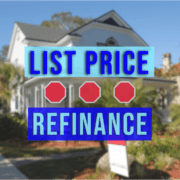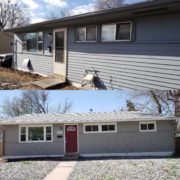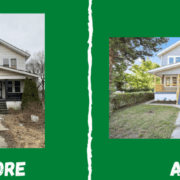3 Ways to Refinance Out of a Fix-and-Flip
Categories: Blog Posts
This market can put your flips in a bad spot – here are 3 ways to refinance out of a fix-and-flip!
As a flipper, you’ve probably noticed the change in the market.
Properties are sitting on the market longer, and price decreases are not helping. When your flip lender comes calling for their money back, what are you supposed to do?
You have two options:
- Take the price hit, sell, and cut your losses.
- Refinance.
Often, refinancing can get you out of a bad spot and still let you come out with a profit. Let’s go over your options and review 3 ways to refinance out of a fix-and-flip.
Why Should You Refinance a Fix-and-Flip?
The most important thing about this market is that you use it to your advantage to prepare for the next market.
We anticipate that over the next 12 months:
- The Fed is going to continue raising rates.
- The economy will soften.
- There will be great real estate deals like we haven’t seen in years.
You want to make sure you’re money-ready for those opportunities. You don’t want properties sitting on the market, taking up your time and energy, and tying up your funds.
So when you have a house that just won’t sell… What are you supposed to do?
Of course, there are traditional refinance methods. You can go to a bank and get a Fannie or Freddie non-conforming loan. But these loans need you to fit into a pretty small box. What if you own too many properties? Or you need your refinance loan fast? What if you don’t fit in the box?
That’s where these 3 unique loans to refinance out of a fix-and-flip come in handy.
1. DSCR Loan
Are you open to keeping your flip for a little longer term? Would you convert it to a rental in the meantime? If so, a DSCR loan is a great way to refinance out of a fix-and-flip.
A DSCR loan is a type of rental loan, based only on:
- Your credit
- Rental income from the property (not your personal income)
- LTV (appraisals, listing price, etc that show the value of the home)
If you’re considering a DSCR loan, let’s look at the pros and cons of shifting gears from a flip to a rental.
DSCR Loan Pros
A DSCR lender will loan you up to 80% of the value of the home.
Cash Flow Opportunity for Your Flip
Your options for a DSCR loan product are broad. You can get anything from an interest-only to a 40-year loan.
With these options, you can spread the payments out. With lower payments and a potential tenant, you can match the cash flow to break even on the property (or maybe even bring in positive cash flow!).
This cash flow frees up your money to buy more flips and keep your business going. With that free money, you can jump on the good deals that will pop up in the next few months.
“Easy” Loan
Some of the biggest advantages of a DSCR loan is how easy it can be to apply and qualify.
For this type of loan, there are no income requirements. You just need good credit and rent that covers the monthly loan payment.
DSCR Loan Cons
There’s one important trick to refinancing a house that’s been on the market:
The appraiser is going to use the last price the house was listed for in their appraisal.
It’s tempting to drop the price when you have a flip on the market to try and attract a buyer. But once you decide to refinance, your house won’t appraise for higher than that lowest listed price.
So, it’s important to decide what you want to do with a flip ASAP. If you know you may want to refinance, you don’t want to keep lowering the list price, or it will negatively impact you.
Pre-payment Penalty
All DSCR loans have some kind of pre-payment penalty. Many are for around 3 years.
This means you have to keep the loan for that period of time, otherwise you’ll be charged a percentage fee for paying off the loan early.
If you want to keep this loan on your property for less than 3 years, you’ll be stuck paying that pre-payment penalty with a DSCR loan.
Not Available for Rural Areas
Also, DSCR loans are not designed for smaller towns. They can be great if you’re in a larger community, but they’re just not available in small ones.
And as money tightens up overall in the real estate lending space, DSCR programs are tightening up too. Rates will go up, LTVs will go down, and they will concentrate more on city centers.
Most DSCR loan programs go as far as 25 miles from a city. But anything that shows up rural on an appraisal will likely not qualify for DSCR.
2. Bridge Loan
A bridge loan is a short-term loan that’s designed to give you flexibility on flips that are slow to sell.
With a bridge loan, you’re free to keep the house on the market, or convert it to a rental. The main purpose of a bridge loan is to get you out of a tough situation with the lender of your flip. What you choose to do with the house afterward is flexible with a bridge loan.
Bridge Loan Pros
Bridge loans are designed to help you refinance out of a flip. It gets you out of your original loan quickly –which is crucial when you’re getting calls from your lender. Plus, it helps you from paying high monthly payments with no cash coming in.
Additionally, bridge loans:
- have no pre-payment penalty
- can be interest only
- close very quickly.
Bridge Loan Cons
Too Short-Term?
Bridge loans are short-term – varying between 1 and 3 years.
In our market, we don’t expect interest rates to trend down for at least another year. If your bridge loan only covers you for a year, that might not be enough time to carry you into a better market.
You’ll want your refinance bridge loan for at least 2 years to give you some flexibility with the property.
You may need to shop around – 3-year bridge loans can be difficult to find, and many are limited to 1 year only.
Low LTV
Bridge loans are usually only 65% to 70% of the house’s current appraised value.
Again, remember that your listing price will have a direct impact on that appraised value. If you slide the price down on the market to attract buyers, your refinance loan will be lower.
DSCR vs Bridge Loan to Refinance Out of a Fix-and-Flip
When we meet with a client about how to refinance out of a fix-and-flip, we weigh DSCR loans against bridge loans.
There’s always a tipping point – usually somewhere between the 14th and 17th month of a DSCR loan – where the pre-pay fee becomes cheaper than a bridge loan.
Bridge loans typically have 2% to 4% higher annual rates over a DSCR loan. Always analyze this tipping point, and choose the right loan for you based on the length you’ll need it.
3. Real OPM
When it comes to real estate investing, OPM is almost always the best choice.
OPM is Other People’s Money. You match up with a real person you know who has money. These are usually retired people, or people nearing retirement.
Inflation is hitting them as bad as it’s hitting you. If they have a lot of cash, they probably want to put it somewhere more stable than stocks and with a better return than a bank account.
If you can offer these people a 5% to 7% return, they may be willing to become your lender. OPM isn’t as concerned about typical loan qualification requirements. Done right, OPM is a win-win for both parties.
OPM is the fastest, easiest, cheapest way to refinance out of a fix-and-flip. Real OPM is what you need most now. Prioritize finding these lenders.
What Are Your Next Steps to Refinance Out of a Fix-and-Flip?
If you have a flip that’s in trouble, let us know. We can help you find your tipping point between DSCR or bridge loans.
We fund some loans ourselves, and we scour the nation looking for all the best loan products available. Let’s find the best debt for your position.
Send your questions to Info@TheCashFlowCompany.com. We’re happy to look at your loan, and if we can’t help you, we probably know someone who can.











